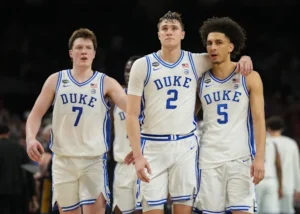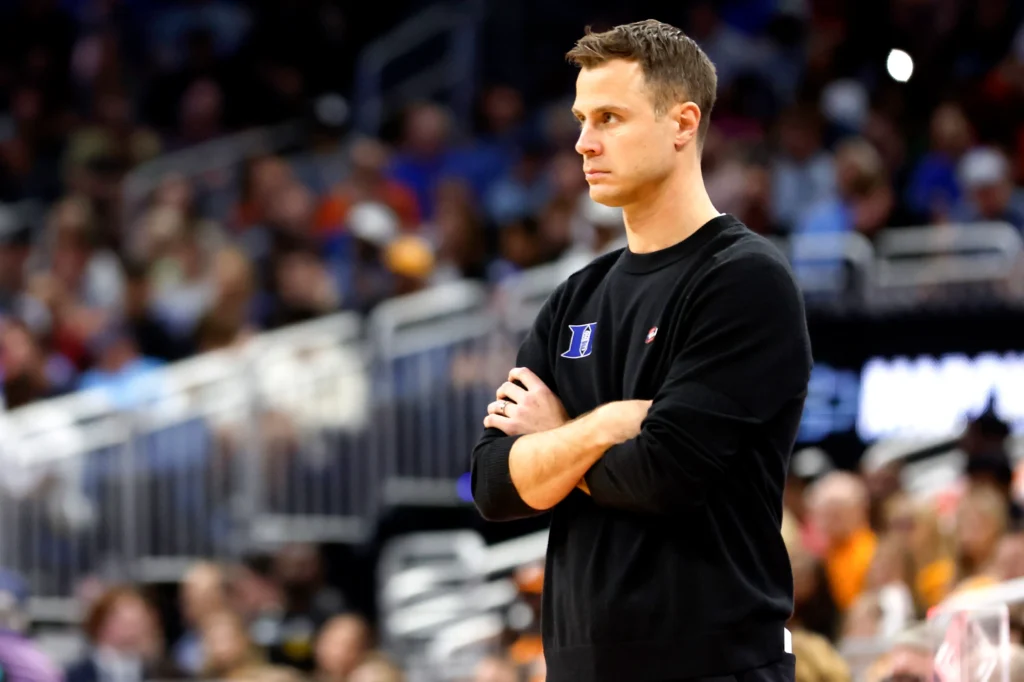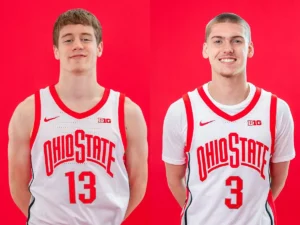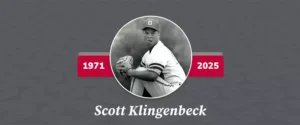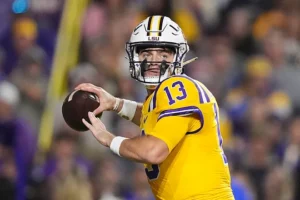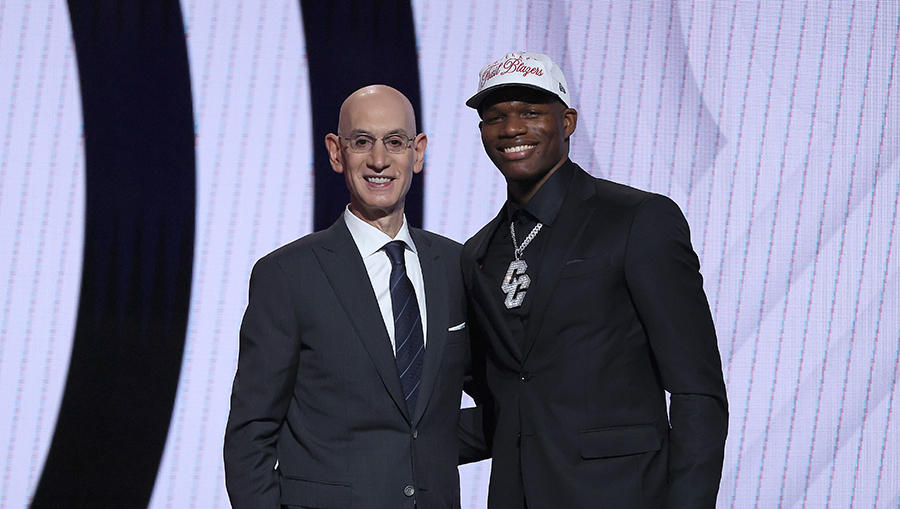
When the hardwood lights illuminated the stage on June 26, 2025, and Commissioner Adam Silver’s voice boomed over the PA system at Brooklyn’s Barclays Center, Cedric Coward’s journey reached its most pivotal point. Shifting from Division III basketball to a guaranteed first-round lottery pick and then being traded immediately to Memphis, Coward’s story reads like a modern basketball odyssey. The Portland Trail Blazers selected him 11th overall only to deal him to the Memphis Grizzlies in one of draft night’s most significant moves. That rapid pivot — from surprise pick to valuable trade asset — highlights not only Coward’s intriguing arc but also the NBA’s ruthless combination of scouting precision and strategic roster-building.
Six-foot-six with a staggering 7-foot-2 wingspan, Coward entered the draft combining extensive defensive potential and offensive promise, despite an abbreviated final college season. His measurables alone were enormous at the NBA Combine—6′5″¼ barefoot, 213 pounds, a 7′2¼″ wingspan, 8′10″ standing reach, and a 38.5″ vertical leap. Those tools are hard to ignore: ideal for a switchable wing capable of guarding multiple positions and contesting shots in space.
Coward’s story begins modestly. After graduating from Fresno’s Central High School, he walked on at Division III Willamette University. There, he averaged an eye-popping 19.4 points and 12 rebounds per game, claiming Northwest Conference Freshman of the Year1. That performance sparked a move to Eastern Washington, where he posted 15.4 points and 6.7 rebounds as a junior and earned First‑Team All-Big Sky honors in 2024. A further transfer landed Coward at Washington State in 2024–25, where he burst onto the scene: in just six games, he averaged 17.7 points, 7 rebounds, 3.7 assists, and added 1.7 blocks per game before a season‑ending shoulder injury.
Even with this abbreviated sample, he flashed hot shooting: 55.7 % field-goal percentage and 40 % from three, translating to a 60 % effective field-goal mark off catch-and-shoot looks. Scouts were impressed: RotoWire noted his reliable perimeter stroke, rebounding, instincts, motor, and switchable defense . He climbed draft boards into a mid-to-late lottery slot. Bleacher Report’s Jonathan Wasserman ranked him 8th on his big board.
That upward trajectory culminated on draft night. Picked 11th by Portland, Coward was immediately sent to the Grizzlies in an aggressive trade. Memphis surrendered the 16th pick (Yang Hansen), a 2028 first-rounder via Orlando, and two seconds to land Coward’s services. The Blazers, in return, snagged Hansen, who’ll bring size and skill to Portland, plus expanded pick capital to fuel future moves or talent accumulation.
On paper, this deal empowered both sides. Portland, choosing assets over immediate talent, gains flexibility vital to a rebuild that hinges on youth and cap management. Memphis acquires a plug-and-play, two-way wing in a system that celebrated that type of player during their “Grit-and-Grind” era. The Grizzlies had traded scorer Desmond Bane to Orlando on June 15, opening a spot that needed replacing. Coward’s shooting and defensive tools made the fit obvious .
Analysts largely applauded the move. ESPN’s Jeff Goodman heard GMs praise Coward’s versatility and locker room maturity, while Field Level Media declared Memphis “made one of the first big moves” to address roster needs. The New York Post awarded the Grizzlies a “B” for Coward’s selection, noting that replacing Bane with a physical and skilled wing made sense. MidMajor Madness highlighted his ascent from small-school ball to lottery pick, emblematic of the transfer-and-development pipeline shaping modern college basketball.
On social media, Memphis fans cheered. One user declared, “WOW GRIZZLIES W,” while others praised his fit with the team’s culture and dismissed the perceived overpay, quipping the extra picks weren’t all that valuable compared to his upside. Even skeptics admitted the move was logical if Coward delivers.
Coward’s own response reveals quiet confidence. “I know the Grizzlies were interested in me, actually, during the season,” he disclosed in his introductory media call . He further vowed to bring a tenacious mindset: “I’m a guy that’s going to get after it each and every day…understand that I need to do what I need to do to get on the court and earn rotation minutes”. He emphasized that nothing, not even being drafted 11th, comes without daily grind.
He embraced the Grit-and-Grind ethos. “It’s a story of ‘I’m gonna go get it.’” And for Coward, the ultimate challenge may lie in his ability to back it up on the court. He signaled eagerness to test himself early, calling playing LeBron James “surreal” but a chance to prove his mettle.
Still, question marks remain. His junior season ended prematurely, offering limited recent game tape. Scouts flagged potential lack of burst and occasional shot-selection and defensive lapses from smaller sample sizes . But the tools are undeniable: size, length, shooting, motor. In Memphis, a city and coaching staff famed for turning players with untapped potential into defensive enforcers, Coward seems poised for significant opportunity.
Portland, sparked by the trade, gained draft capital and a promising big in Yang Hansen, a 7-foot pivot from China likened to a “Chinese Jokic” by AS Mag. With Hansen’s 16th pick secured, the Blazers pivoted toward cost-controlled youth and long-term flexibility — hallmarks of a patient rebuild aiming to attract free agents or facilitate mid-level trades.
Coward’s selection also carries historical resonance for Washington State basketball. Only Klay Thompson had previously been drafted that high — 11th overall in 2011 — and Coward is the fourth Cougar to hear his name called in five years, with WSU boasting first-rounders in 2023, 2024, and now 2025. That streak reflects WSU’s growing reputation as a legitimate NBA pipeline, born of smart recruiting, development under coach David Riley, and willingness to attract overlooked talent.
As the Grizzlies’ 2025–26 roster took shape—with Ja Morant, Jaren Jackson Jr., and newly minted lottery picks filling out the core—Coward steps into a system with a winning culture and high expectations. His work ethic, defensive edge, and perimeter shooting promise to mesh with the head coach and front office blueprint. If he adjusts swiftly, his draft night move could signal a pivotal moment—giving Memphis a homegrown, culture-first wing in the mold of Dillon Brooks or Kyle Anderson.
Portland, meanwhile, demonstrated pragmatic roster craftsmanship. Trading down from 11 to 16 plus multiple future assets grants them roster flexibility. They avoided a lottery pick in a deep class to stockpile draft equity and youth, aligning with a timeline built around building a stable foundation of young, affordable talent. Rebuilding is a marathon, not a sprint, and the Coward trade underscores that process.
For Cedric Coward himself, 2025 marks not just a draft moment, but culmination and beginning. From walk-on at a Division III school to Division I, overcoming injury, earning combine invite, and showing poise off the court — his narrative is steeped in resilience. Now, his challenge is to show basketball translation: stay healthy, adapt to NBA pace, earn minutes, and carve a role using his shooting and defensive versatility.
The upcoming season will be his true audition—how well Memphis adapts him, how quickly he picks up rotations and schemes, and whether he can consistently compete at the NBA level. Can he guard two or three positions, hit open threes, and crash the glass effectively? If so, he’s the rare lottery pick from a non-traditional path who could pay immediate dividends.
Draft night dealt its surprises. First Portland selected Coward 11th, then sent him to Memphis just hours later. But each transaction tells a clear story: the Blazers stockpiling flexible assets, the Grizzlies betting on a culture-first wing to plug a roster hole left by Bane. It’s the kind of win-win move increasingly common in today’s NBA.
Whatever unfolds, Cedric Coward’s unlikely climb from obscurity to national attention serves as a compelling reminder: opportunity favors preparation, and scouting identifies unique talent. He broke into the first round not by conventional recruitment or rankings, but through skill cultivation, perseverance, and seizing every opportunity—enough to convince NBA executives he belonged.
So when June rolls around in 2026, all eyes will be on Memphis to see whether Coward has quietly cemented himself as the two-way wing they envisioned. His rookie résumé will speak louder than any draft-night hype. But for now, at 21, he stands at a crossroad with wings unfurled: drafted by one franchise, claimed by another, and ready to write the next chapter of an improbable—but glowing—career.
